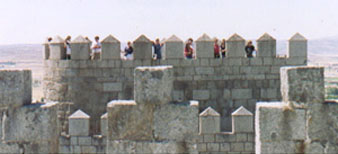Program Headquarters
Madrid, Almuñécar, and Leon
The Orientation program starts in excitement of Spain's capital, Madrid, including visits to the magnificent Prado Museum, and then goes to Almuñécar, a quaint beach-side village on the Mediterranean Sea near Málaga. Following two days of peaceful cultural activities, the Program moves from town to town, to observe Granada and the Alhambra Palaces, the flamenco gaity of Sevilla, Córdoba with its Great Mosque and Judería Barrio. The Orientation ends with the visit of the Roman city of Mérida, the cherry harvest of the Jerte Valley, and the university city of Salamanca.

SIHS '94 Group at the Walls of Avila
The Orientation includes civilization, language and conversation classes, an essay and language placement test, and visits to a rich variety of sites and events, designed to ease the student’s transition into the linguistic, cultural, academic and psychological milieu of Spain. Orientation classes, taught by two of our University of León professors, will count as the introductory part of the University of León courses. Because the Orientation has proven so important as a means to gain the confidence and to acquire the skills necessary for the university experience, it has been extended to a week. The unique SIHS experience also helps the students develop a cohesive group identity and provides the necessary structure for the initial implementation of the strict Spanish-only rule.
After this intense Orientation experience, the students move on to León, the principal stopping place along the ancient prilgrimage route to Santiago de Compostela and the gateway to the northwestern provinces of Asturias and Galicia for all those coming from Madrid, 200 miles to the south. León, one of the oldest regional capitals of Spain (“without León Spain would not exist,” says the proud, ancient hymn of the León Kingdom), is a modern, medium size Spanish city, boasting remarkable artistic, architectural treasures dating from Roman times and from the 10th to the 21st centuries and a temperate, summer climate (being 2,750 feet above sea level). It is a personable, entirely accessible town of manageable proportions, free of the incumbrances of heavy tourism, the presence of many other foreign programs or the impersonality of a large metropolis. It is unique in its specimens of the Spanish romanesque and plateresque styles, including the Collegiate Church of San Isidoro (with the most splendid and genuine examples of Romanesque wall paintings, architecture and sculpture) and the awesome Renaissance Convent of San Marcos (now housing the country’s very best National Parador), and, above all, as the site of what many consider the greatest, most beautiful, and purest Gothic style cathedral to be found in Spain.
